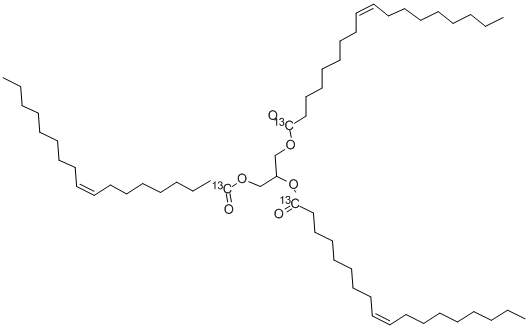OleicAcid-13C , ≥98% , 82005-44-5
| Pack Size | Price | Stock | Quantity |
| 5mg | RMB2015.20 | In Stock |
|
| 100mg | RMB12000.00 | In Stock |
|
| others | Enquire |
PRODUCT Properties
| Melting point: | 13.4 °C(lit.) |
| Boiling point: | 192-195 °C1.2 mm Hg(lit.) |
| Density | 0.893 g/mL at 25 °C |
| refractive index | n |
| Flash point: | >230 °F(lit.) |
| storage temp. | -20°C |
| solubility | Ethanol: 1.5 mg/ml; Ethanol:PBS (pH 7.2) (1:1): 0.5 mg/ml |
| form | Liquid |
| color | Colorless to light yellow |
Description and Uses
Oleic acid-13C is intended for use as an internal standard for the quantification of oleic acid (Item Nos. 90260 | 24659) by GC- or LC-MS. Oleic acid is a monounsaturated fatty acid and a major component of membrane phospholipids that has been found in human plasma, cell membranes, and adipose tissue. It contributes approximately 17% of the total fatty acids esterified to phosphatidylcholine, the major phospholipid class in porcine platelets. Oleic acid inhibits collagen-stimulated platelet aggregation by approximately 90% when used at a concentration of 10 μg/ml. It also inhibits fMLF-induced neutrophil aggregation and degranulation by 55 and 68%, respectively, when used at a concentration of 5 μM, similar to arachidonic acid (Item Nos. 90010 | 90010.1 | 10006607). Oleic acid (60 μM) induces release of intracellular calcium in human platelets. In vivo, oleic acid increases TNF-α, IL-8, IL-6, and IL-1β production, neutrophil accumulation, and apoptotic and necrotic cell death in mouse lung and has been used to induce lung injury in a mouse model of acute respiratory distress syndrome (ARDS).
Labelled Oleic acid. Obtained by the hydrolysis of various animal and vegetable fats and oils.
Safety
| Symbol(GHS) |  GHS07 |
| Signal word | Warning |
| Hazard statements | H315-H319 |
| Precautionary statements | P264-P280-P305+P351+P338-P337+P313P-P264-P280-P302+P352-P321-P332+P313-P362 |
| WGK Germany | 3 |



